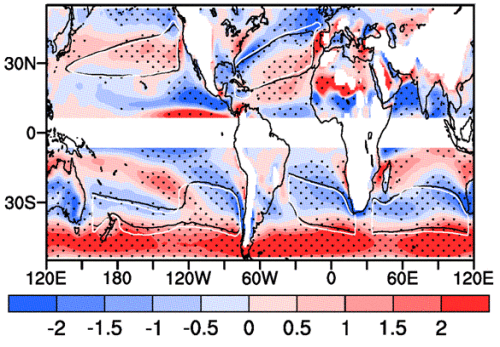

Subtropical anticyclone is an essential component of the atmospheric circulation in the subtropics, responsible for the formation of subtropical monsoons and deserts. There are two subtropical anticyclones in the subtropical northern hemisphere in boreal summer, and three subtropical anticyclones in the subtropical southern hemisphere in austral summer. These five summertime subtropical anticyclones are all located at the lower troposphere over the subtropical oceans.
To assess the possible responses of the subtropical anticyclones to greenhouse gases (GHG) forcing, Dr. He Chao from the China Meteorological Administration, and Drs. Wu Bo, Zou Liwei and Prof. Zhou Tianjun from the Institute of Atmospheric Physics, CAS, adopted multiple metrics and obtained robust results. Coupled models under GHG forcing show that the subtropical anticyclones over the North Pacific, South Atlantic and South Indian Ocean will become weaker in future under RCP8.5 scenario, whereas the subtropical anticyclones over the North Atlantic and South Pacific will become stronger.
"Intensity change of the subtropical anticyclones to GHG forcing is dominated by two factors -- the enhanced tropospheric static stability and the pattern of change in diabatic heating", said Dr. He. “The tropospheric static stability is enhanced via moist adiabatic adjustment under GHG forcing, and it acts to reduce the intensity of all the subtropical anticyclones. Meanwhile, the pattern of change in the tropospheric diabatic heating acts to weaken the North Pacific subtropical anticyclone but to enhance the subtropical anticyclones over the North Atlantic and South Pacific.”
"Our findings show evidences that the global warming has different impacts on the global subtropical anticyclones”, said Dr. Zou Liwei, the co-author of the paper. "The intensity of North Pacific subtropical anticyclone reduces significantly, since both the enhanced static stability and enhanced diabatic heating act to weaken it. Over the South Atlantic and South Indian Ocean, the effect of enhanced static stability dominates, and the subtropical anticyclones over these two basins also become weaker. The effect of reduced diabatic heating overwhelms the effect of enhanced static stability over the North Atlantic and South Pacific, and their combined effect enhances these two subtropical anticyclones."
This study was recently published in Journal of Climate.
Reference: He C, Wu B, Zou L, Zhou T (2017) Responses of the Summertime Subtropical Anticyclones to Global Warming.J Climate 30 (16):6465-6479.

Projected future change of relative vorticity at 925 hPa. The black and white contours show the climatology for the 20th and 21st centuries. The shading shows the projected change by the ensemble mean of 30 models, and the projected sign of change agreed by more than 70% of the models is stippled. (Reprinted from He et al., 2017)
For more information, please contact:
He Chao
China Meteorological Administration
or Institute of Atmospheric Physics, CAS
E-mail: hechao@mail.iap.ac.cn
Source: Institute of Atmospheric Physics, CAS